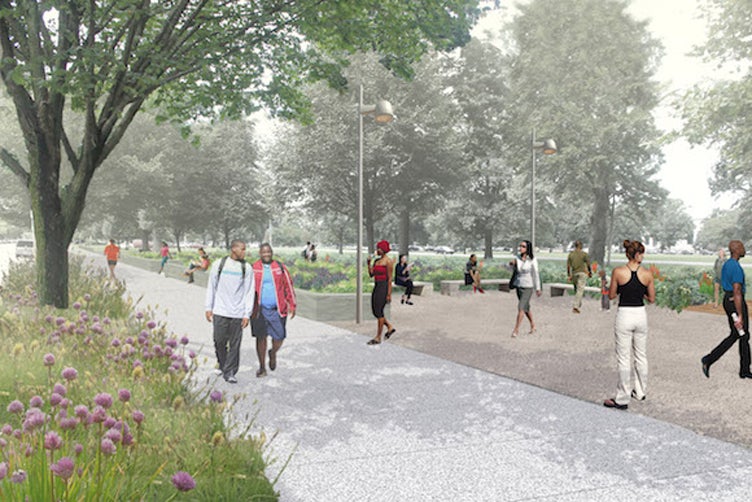Praxis Dialogues: The importance of inclusive urban design, now

On December 1, PennPraxis and PlanPhilly will kick off Praxis Dialogues, the first in a series of public conversations about the notion of “the public good” in design practice, and how it informs and affects the design and use of spaces in the public realm. As a provocation before that conversation, we’re sharing commentaries from the panelists. So far Randy Mason, executive director of PennPraxis, teed up this conversation, and the Community Design Collaborative’s Beth Miller explored the power of public interest design. Today, David Gould, a program offier at the William Penn Foundation, discusses the value of creating inclusive design processes.
Kicking off the Praxis Dialogues series, Randy Mason posed the question: “How does our shared, ‘public’ realm express and live up to our political and social ideals?” Beth Miller followed up with insights about the importance of public interest design and how the Community Design Collaborative approaches that work. I would like to double down on Beth’s thoughts and make the case that not only does an inclusive design process yield a better outcome, but it is also a valuable tool in preparing community stakeholders to shape the communities in which they live.
The ‘public realm’ is often defined as publicly-owned streets, pathways, parks, and other generally publicly-accessible spaces. I would contend, however, that we should also consider a definition of the public realm that extends beyond spaces that are purely public in nature. Instead, this ‘realm’ includes both the public (e.g., parks, sidewalks) and private (e.g., businesses) spaces that make up the fabric of our city. It’s not just the local pocket park, it’s the restaurant that it sits in front of; it’s not just the neighborhood library, it’s the corner store, school, and childcare center that populate the rest of the block; it’s not just the community park, it’s the rowhouses, businesses, and apartments that surround it. These public and private entities are inextricably linked. Ideally, they are mutually supportive of each other and—together—create the communities we all live in and the context in which new spaces are designed. This means we should insist that the design of public and private projects be of equally high quality and that communities are equipped to have a voice in shaping both.
In order to create a public realm that serves the public good, the design process should be just as reflective of our ideals as the physical product. At the William Penn Foundation, those ideals include community, equity, inclusion, and stewardship.
In early 2013, the Foundation launched a new set of strategic priorities. A key component of our approach is a funding stream dedicated to the development, activation, and stewardship of “Great Public Spaces.” Building on successful projects that we supported under our previous strategic plan—many of which, such as Sister Cities Park, Franklin Square and Independence Mall, were located in Center City—the Foundation decided to pivot and focus on projects in neighborhoods outside of our now burgeoning downtown.
As we embarked on this new approach, we quickly decided that if we were going to support projects that would be true community assets and would serve the public good, we needed to ensure an intentional design process. In our minds, the only way to accomplish this is to engage the community in a sincere way and empower community members—those whom we are seeking to serve—in shaping the vision of the project.
These principles predate our current strategic priorities. The Delaware River Waterfront Corporation’s Master Plan for the Central Delaware, which the Foundation supported in the mid-2000s, is an illustrative example of how meaningful community engagement, through an initial civic visioning process, resulted in a plan that is oriented around serving public interests. Almost a decade later, we are seeing the fruits of that process in the form of new pier parks, trails, the ever-popular Spruce Street Harbor Park, and even welcome forthcoming private development along our waterfront that maintains public access as a required component.
Building on that experience, we’ve found that these principles of citizen-driven design become all the more important for projects in communities that, historically, have received inadequate levels of attention and investment. We are aware that residents and community stakeholders may be skeptical, and understandably so, about new interest and amenities in their community when such investment and interest have been absent for so long. How will this new investment change the public realm and the character of their neighborhood? What development—public and private—will follow and whom will it serve? This justified trepidation should not, however, discourage us from investing in vibrant and high-quality parks and other public assets that these communities so rightfully deserve. Instead, it is incumbent upon funders, government, and design professionals to empower communities to influence the design process and utilize their perspective as an asset for the overall vision of the project.
We are confident that inclusive, public interest design is critical for spaces that reach their full potential and we have been transparent with grantees about our commitment to this approach in any project we support. While approaches to inclusive design can vary, this often means that community leaders, both formal (e.g., community development corporations, civic associations, churches, etc.) and informal (e.g., block captains, long-time residents), are engaged on an ongoing basis to provide input and ensure buy-in. Additionally, we look to avoid projects that appear to be conceptualized in a ‘top-down’ manner, lack evidence of community buy-in and input, or do not present plans to include the community’s voice in a meaningful way.
With the energy of Center City spilling out into neighborhoods across the city, communities must be all the more ready to engage with government, developers, and institutions in productive ways that will enable them to help shape the evolution of their own public realm; thus promoting cohesion as opposed to contention. Well-designed public spaces have the potential to be platforms for civic engagement, community building, equity, and inclusion; and a genuinely inclusive design process is the necessary precursor. Not only does this strengthen the immediate project at hand, but it also provides other benefits such as a sense of community ownership, incentive for stewardship, as well as established community organization and experience that can enable neighborhood stakeholders to engage in the design of future projects—public or private—as their public realm may continue to evolve.
While I am not a trained design professional, my understanding is that Louis Sullivan’s famous phrase ‘form ever follows function’ was meant to convey that the final design of a building or space should be reflective of its utility and purpose. Perhaps we all should extend Sullivan’s notion to the actual process of design: If the design process is a function of inclusion, equity, and engagement then the final product (or form) will be reflective of those ideals as well. As we continue to grow as a city, the timeliness of this practice becomes all the more important.
WHYY is your source for fact-based, in-depth journalism and information. As a nonprofit organization, we rely on financial support from readers like you. Please give today.





